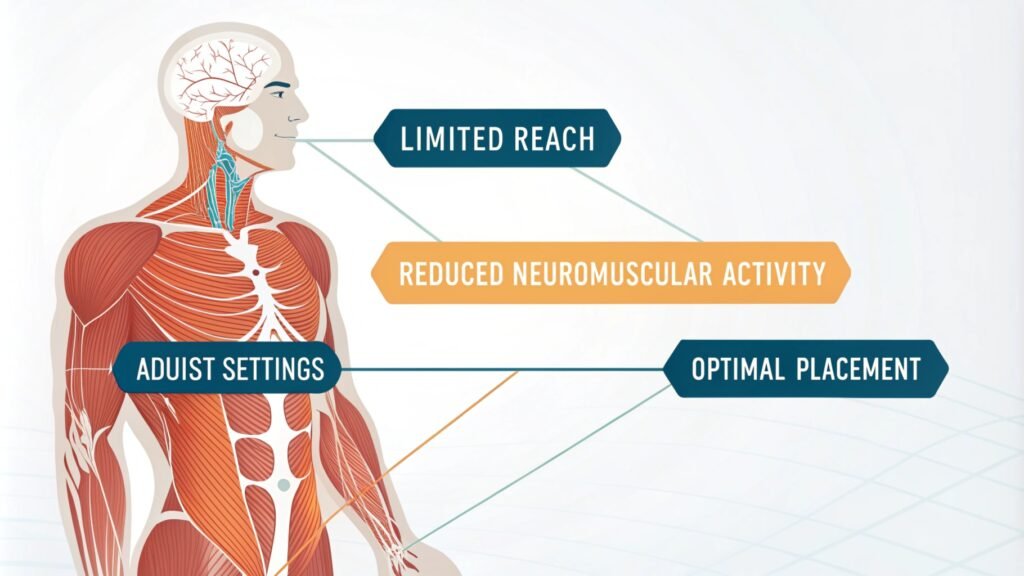Are sore muscles slowing you down? Whether you're an athlete or recovering from an injury, muscle recovery can feel like an uphill battle. Electrical Muscle Stimulation (EMS) can accelerate muscle recovery by reducing soreness and improving blood flow. Learn how to maximize its benefits.
EMS is a game-changer, but only when used correctly. Let’s dive into the science, techniques, and myths surrounding it to help you recover faster and smarter.
What frequency is best for EMS muscle recovery?
Frequency is a key factor in the effectiveness of EMS for recovery. Using the wrong one may reduce its impact or even cause discomfort.
For muscle recovery, a frequency between 5-20 Hz is typically optimal. This range mimics natural muscle twitching, promoting relaxation and circulation.

How does frequency affect muscle recovery?
The frequency determines how your muscles respond to stimulation. Low frequencies help relax muscles by encouraging natural contractions without causing fatigue.
| Frequency Range | Purpose | Effect |
|---|---|---|
| 5-20 Hz | Recovery | Boosts blood flow, reduces tension |
| 20-50 Hz | Strength Building | Promotes hypertrophy |
| 50-100 Hz | Intense Workouts/Endurance | Builds power and stamina |
Sticking to 5-20 Hz ensures muscles recover without the strain of higher frequencies.
Are there risks to using the wrong frequency?
Yes, using too high a frequency during recovery could lead to over-stimulation, muscle fatigue, or unnecessary soreness. Always adjust based on your recovery goals and comfort level.
How long should you leave EMS on?
Time plays a big role in effective EMS sessions. Overdoing it can strain your muscles, while too little might not yield results.
The ideal EMS session lasts 15-30 minutes for recovery. This time frame allows for improved circulation and relaxation without overstressing the muscle.

Why does duration matter?
Duration controls how long your muscles are engaged. Short sessions allow recovery processes to kick in, while overly long sessions could reverse these benefits.
- Short Sessions (<10 min): Useful for a quick refresh post-workout.
- Medium Sessions (15-30 min): Ideal for comprehensive recovery.
- Long Sessions (>30 min): Risk of fatigue or discomfort, unless prescribed for specific medical purposes.
Can you use EMS too often?
Using EMS too frequently, especially for recovery, can interfere with your body's natural healing. Limit recovery-focused EMS to 3-5 sessions weekly unless advised otherwise by a professional.
How long does it take to see results with EMS?
Results can vary based on your recovery needs and consistency in using EMS.
Most users notice reduced soreness and improved flexibility within 1-2 weeks of consistent use. Long-term benefits, like enhanced muscle strength, may take a month or more.

What factors influence EMS effectiveness?
The time to see results depends on several variables:
- Intensity: Higher intensities deliver faster results but should be balanced with recovery goals.
- Frequency of Use: Regular sessions yield quicker outcomes.
- Baseline Condition: Athletes or those recovering from injury may notice quicker or slower effects depending on their starting point.
Success Stories: What do users say?
Many users report faster muscle relief after workouts or injuries. For instance, a runner shared how 20-minute EMS sessions post-race reduced her soreness significantly by the next day. Combining EMS with proper hydration and stretching enhances these results.
Do cheap EMS machines work?
The market is flooded with EMS devices, but not all are created equal. Budget devices are tempting, but do they get the job done?
Cheap EMS machines can provide basic stimulation but may lack the customization or power of premium models. For muscle recovery, investing in a quality machine ensures consistent results.

What makes a good EMS machine?
A quality EMS machine offers:
- Adjustable frequencies for recovery and strength-building.
- Comfortable electrode pads for different muscle groups.
- Reliable battery life and durability.
Premium devices may also feature pre-set programs tailored for recovery, which cheaper models often lack.
| Feature | Cheap EMS Machines | Premium EMS Machines |
|---|---|---|
| Frequency Range | Limited | Wide and customizable |
| Build Quality | Basic | Durable and ergonomic |
| User Interface | Simple, manual | Advanced, pre-set modes |
When is a budget EMS machine enough?
If you're new to EMS and only need light recovery support, budget devices can suffice. But if you're an athlete or need precise recovery post-injury, a premium device is a better investment.
Which muscle is not responding to electrical stimulation?
Despite EMS's versatility, not all muscles respond equally to stimulation. Some areas may resist or fail to show immediate improvement.
Deeper or highly fatigued muscles may not respond to EMS due to limited electrode reach or reduced neuromuscular activity. Adjusting settings and placement often solves this.

Why do some muscles resist EMS?
Several factors can affect EMS's effectiveness:
- Depth of Muscle: Deeper muscles like the iliopsoas may be harder to target.
- Fatigue or Damage: Overworked or injured muscles might need rest before responding.
- Improper Electrode Placement: Incorrect placement can reduce efficacy.
How to troubleshoot non-responsive muscles?
- Reposition Electrodes: Move them closer to the muscle origin or belly.
- Increase Intensity Gradually: Start low and raise intensity to stimulate dormant fibers.
- Alternate Sessions with Rest: Avoid overuse of EMS on the same muscle group.
When to seek professional advice?
If a muscle consistently fails to respond despite adjustments, consult a physiotherapist. They can identify underlying issues and suggest targeted treatments.
Conclusion
EMS is a powerful tool for muscle recovery when used correctly. Optimal frequency, duration, and device quality make all the difference. Combining EMS with proper hydration, rest, and stretching ensures the best results. With consistent use, you'll recover faster and perform better.





